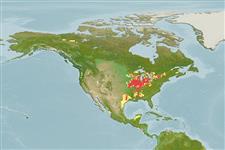Classification / Names
Common names | Synonyms | Catalog of Fishes (gen., sp.) | ITIS | CoL | WoRMS | Cloffa
Actinopterygii (ray-finned fishes) >
Lepisosteiformes (Gars) >
Lepisosteidae (Gars)
Etymology: Lepisosteus: Greek, lepis = scale + Greek, osteon = bone; bony sacled (Ref. 45335); oculatus: From the word oculatus, meaning eyed (referring to the ocellus-like spots on the body) (Ref. 10294).
Environment / Climate / Range
Ecology
Freshwater; brackish; demersal. Temperate; 12°C - 20°C (Ref. 2060), preferred ?; 43°N - 28°N
North America: Lake Erie and south Lake Michigan drainages south through Mississippi River basin to Gulf Slope drainages from lower Apalachicola River in Florida to Nueces River in Texas, USA.
Length at first maturity / Size / Weight / Age
Maturity: Lm ?, range 40 - ? cm
Max length : 150 cm TL male/unsexed; (Ref. 57533); common length : 100.0 cm TL male/unsexed; (Ref. 3728); max. published weight: 4.4 kg (Ref. 40637); max. reported age: 18 years (Ref. 12193)
Profusion of dark spots on the body, head and fins. Dark in coloration (Ref. 37032).
Adults occur in quiet, clear pools and backwaters of lowland creeks, small to large rivers, oxbow lakes, swamps and sloughs. Occasionally enter brackish waters. A voracious predator feeding on various kinds of fishes and crustaceans.
Robins, C.R., R.M. Bailey, C.E. Bond, J.R. Brooker, E.A. Lachner, R.N. Lea and W.B. Scott, 1991. Common and scientific names of fishes from the United States and Canada. Am. Fish. Soc. Spec. Pub. (20):183 p. (Ref. 3814)
IUCN Red List Status (Ref. 115185)
CITES (Ref. 94142)
Not Evaluated
Threat to humans
Harmless
Human uses
Fisheries: minor commercial; gamefish: yes
More information
ReferencesAquacultureAquaculture profileStrainsGeneticsAllele frequenciesHeritabilityDiseasesProcessingMass conversion
Tools
Special reports
Download XML
Internet sources
